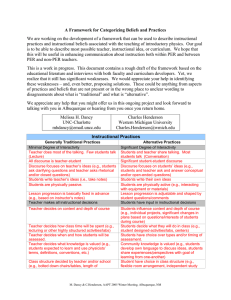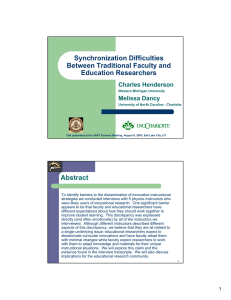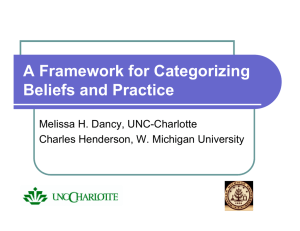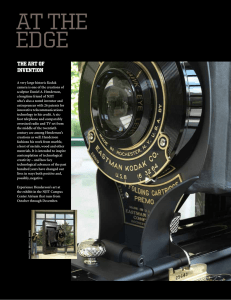Teaching, Learning and Physics Education Research: Views of Mainstream Physics Professors Charles Henderson,
advertisement
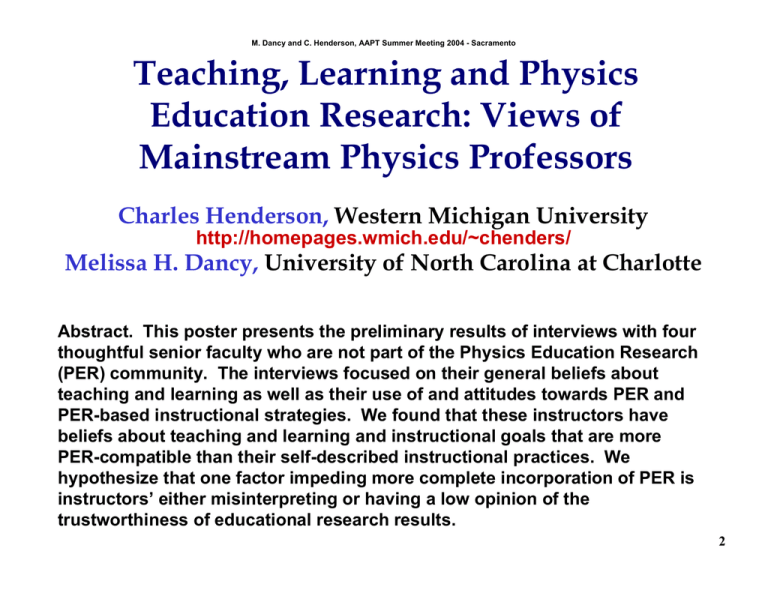
M. Dancy and C. Henderson, AAPT Summer Meeting 2004 - Sacramento Teaching, Learning and Physics Education Research: Views of Mainstream Physics Professors Charles Henderson, Western Michigan University http://homepages.wmich.edu/~chenders/ Melissa H. Dancy, University of North Carolina at Charlotte Abstract. This poster presents the preliminary results of interviews with four thoughtful senior faculty who are not part of the Physics Education Research (PER) community. The interviews focused on their general beliefs about teaching and learning as well as their use of and attitudes towards PER and PER-based instructional strategies. We found that these instructors have beliefs about teaching and learning and instructional goals that are more PER-compatible than their self-described instructional practices. We hypothesize that one factor impeding more complete incorporation of PER is instructors’ either misinterpreting or having a low opinion of the trustworthiness of educational research results. 2 M. Dancy and C. Henderson, AAPT Summer Meeting 2004 - Sacramento Physics Education Research Physics Education Researchers have developed: • Pedagogical knowledge base. • Research-based curricular packages • Significant dissemination efforts 3 M. Dancy and C. Henderson, AAPT Summer Meeting 2004 - Sacramento The Problem In spite of these efforts by the PER community: • Many instructors have very traditional teaching practices. A few possible reasons [Fullan, 2001; Rogers, 1995]: 1. they may not have had much exposure to PER 2. they may have instructional goals that are inconsistent with PER-based instructional strategies 3. they may have the same goals, but believe that their current instruction is successfully meeting these goals 4. they may have beliefs about teaching and learning (e.g., transmission/behaviorist learning theories) that are not consistent with PER curricula 5. they may not believe that they are meeting their goals, but also not believe that any of the PER strategies could do a better job 5 M. Dancy and C. Henderson, AAPT Summer Meeting 2004 - Sacramento Current Study • Open-Ended Interviews • Four instructors, three institutions • Tenured • No formal connections with PER • Thoughtful, reflective, well-respected ÎThis type of instructor is most likely to be influenced by PER •Analyzed: 1.Self-described beliefs, goals and practice. 2.Changes in practice over career. 3.Knowledge and attitudes about PER . 6 M. Dancy and C. Henderson, AAPT Summer Meeting 2004 - Sacramento Self-Described Instructional Practices Traditional 1. Teacher-centered, passive 2. competitive/individualist PER-Compatible 1. Student-centered, active 2. cooperative learning 3. External Motivators 3. Internal Motivators 4. Assess for performance in solving familiar problems 4. Assess for thinking/problem solving skills 5. grades/testing used to sort, rank, certify 5. value all students, assessment for feedback 6. Decisions about what/how to learn made by teacher 7. Teach only physics content T PER T PER 1. +++ 1. + 1. +++ 1. + 2. + 2. 2. ++ 2. +++ 3. +++ 3. 3. ++ 3. + 4. +++ 4. 4. +++ 4. + 5. +++ 5. 5. + 5. 6. + 6. 6. +++ 6. 7. + 7. 7. +++ 7. Gary T Harry PER T PER 1. +++ 1. +++ 1. +++ 1. 2. 2. +++ 2. + 2. 6. Students contribute to decision-making (e.g., projects) 3. ++ 3. + 3. + 3. 4. 4. ++ 4. +++ 4. + 7. Teach learning, thinking, and PS skills and physics content 5. 5. 5. 5. + 6. + 6. 6. + 6. 7. 7. ++ 7. + 7. Mary Terry 7 M. Dancy and C. Henderson, AAPT Summer Meeting 2004 - Sacramento % of coded statements General Trend: PER Beliefs and Traditional Practice PER Compatible 50% 50% Traditional Gary Harry Practice Mary Terry Beliefs 8 M. Dancy and C. Henderson, AAPT Summer Meeting 2004 - Sacramento Self-Described Instructional Practices Traditional PER-Compatible T 1. Teacher ideas are always central, passive students are allowed to be passive 1. Student ideas are often central, mentally active students 1. +++ 1. + 1. +++ 1. + 2. + 2. 2. ++ 2. +++ 3. +++ 3. 3. ++ 3. + 2. competitive/individualist learning modes 2. cooperative learning modes 4. +++ 4. 4. +++ 4. + 5. +++ 5. 5. + 5. 3. External Motivators (grades, testing) 3. Internal Motivators (student interests or needs) 6. + 6. 6. +++ 6. 7. + 7. 7. +++ 7. 4. Assess for quick and accurate performance in solving familiar problems 4. Assess for thinking/problem solving skills using open-ended or novel questions 5. Same instruction for all, diversity seen as a problem, grades/testing used to sort, rank, certify 5. Treat students as unique individuals with different needs, value all students, assessment for feedback 1. +++ 1. +++ 1. +++ 1. 2. 2. +++ 2. + 2. 3. ++ 3. + 3. + 3. 4. 4. ++ 4. +++ 4. + 6. Decisions about what/how to learn made by teacher 6. Students contribute to decision-making (e.g., projects) 5. 5. 5. 5. + 6. + 6. 6. + 6. 7. Explicitly teach only physics content 7. Explicitly teach learning, thinking, and PS skills in addition to physics content 7. 7. ++ 7. + 7. PER T Gary T Harry PER Mary PER T PER Terry 9 M. Dancy and C. Henderson, AAPT Summer Meeting 2004 - Sacramento Instructors Know about PER 3 knew names and basic practices of many PER instructional strategies. 1 instructor exposed to other research-based techniques. Instructional Goals are Consistent with PER Develop Students’ Problem Solving Skills Develop Students’ Understanding of Basic Physics Principles Not Happy With Student Outcomes None believed that they were meeting these goals. All wanted to improve. 10 M. Dancy and C. Henderson, AAPT Summer Meeting 2004 - Sacramento Beliefs About Learning: PER Compatible or Mixed Traditional PER-Compatible 1. Transmission View: Learning is the accumulation of facts or procedures. Students learn best from a clear presentation of ideas. 1. Constructive view: Learning involves qualitative changes in thinking. Students must be mentally active to learn. 2. Learning is primarily an individual activity. 2. Learning is primarily a social activity. 3. Students are generally lazy and unmotivated to learn. External motivation is preferred. 3. Students have a natural desire to learn. Development of internal motivation is preferred and possible. 4. A student who can quickly and accurately solve a set of standard problems understands physics. 4. A student who can solve novel problems and give explanations understands physics. 5. Students learn/think homogeneously. Failure to learn is due to inadequate ability or effort. 5. Students learn/think differently. Failure to learn may be due to a mismatch between student learning needs and course structure. 6. Students cannot assess their level of understanding or learning needs, but need a teacher (expert) to do this. 6. Students can assess their own level of understanding or learning needs. 7. Students should primarily learn physics-related facts and procedures (so they can use this knowledge in the future). 7. Students should learn physics-related thinking/learning/problem-solving skills in addition to facts and procedures (so they can continue to develop their own knowledge in the future) T T PER PER 1. +++ 1. +++ 1. 1. +++ 2. + 2. 2. ++ 2. + 3. + 3. 3. +++ 3. + 4. 4. ++ 4. +++ 4. + 5. + 5. ++ 5. 5. 6. ++ 6. 6. 6. 7. 7. +++ 7. + 7. +++ Harry Gary T PER T PER 1. 1. +++ 1. 1. +++ 2. 2. + 2. + 2. 3. ++ 3. ++ 3. 3. + 4. 4. +++ 4. 4. +++ 5. + 5. ++ 5. + 5. +++ 6. 6. 6. 6. 7. + 7. +++ 7. + 7. +++ Mary Terry 11 M. Dancy and C. Henderson, AAPT Summer Meeting 2004 - Sacramento PER-Compatible Beliefs About Teaching Traditional PER-Compatible 1. Teaching is mainly about imparting information and transmitting the teachers’ knowledge to the students 1. Teaching is mainly about helping students construct their own understanding of the world 2,5. School is a filter - A teacher’s job is to classify and sort students 2,5. School is an empowerment tool – A teacher’s job is to develop thinking/learning skills and competencies of every student. T PER T PER 1. +++ 1. +++ 1. + 1. +++ 2,5. 2,5. +++ 2,5. 2,5. ++ 3. 3. ++ 3. 3. ++ 4,7. 4,7. +++ 4,7. 4,7. +++ 5,6. 5,6. + 5,6. 5,6. +++ 1,7. 1,7. + 1,7. 1,7. +++ Gary Harry 3. A teacher is not responsible for motivating students to learn. 3. Part of a teachers’ job is motivating students to learn. 4,7. Teachers should explicitly teach only physics-related facts and procedures. 4,7. Teachers should explicitly teach physics-related thinking/learning/problem-solving skills in addition to facts and procedures. 1. 1. ++ 1. ++ 1. ++ 2,5. 2,5. + 2,5. 2,5. +++ 5,6. Teacher should teach – organize and deliver content (i.e., cover material) 5,6. Teacher should guide – develop situations where students can learn 3. 3. ++ 3. 3. ++ 4,7. 4,7. +++ 4,7. 4,7. ++ 1,7. Content knowledge is the most important teacher credential. Any expert can teach. 1,7. Teaching is complex and requires skills in addition to content knowledge. 5,6. 5,6. + 5,6. 5,6. +++ 1,7. 1,7. +++ 1,7. 1,7. +++ T PER Mary T PER Terry 12 M. Dancy and C. Henderson, AAPT Summer Meeting 2004 - Sacramento An Example - Gary Goal: Students Learn Problem Solving Skills “I think I’m teaching problem solving. And I’m probably teaching in the broader sense, I’m teaching problem solving in life as much as physics, physics is kind of incidental, almost.” Belief about Teaching: Subject matter is used to teach learning/problem solving skills “I’m not teaching subject matter, the subject matter is a tool to help them [learn problem solving] . . . and I’m also teaching them how to learn.” Belief about Learning: Solving novel problem = problem solving skill “If they are encountering a new application they’re showing problem solving skills in physics, other than just repeating a solution they’ve done before, they’ve seen me do before.” Self-Described Instructional Practices: Lecture based, most exam questions come directly from a study guide he provides. Satisfaction: Not satisfied “I know that most of my students are not learning problem solving. If I change the situation they think it’s a whole new problem.” 13 M. Dancy and C. Henderson, AAPT Summer Meeting 2004 - Sacramento An Example - Terry Belief about Teaching/Learning: Each student learns/thinks differently. An instructor should accommodate this diversity. “In my mind every student has a different way of learning and my challenge, every teacher’s challenge is in fact to find a variety of ways that can engage those students.” Self Described Instructional Practice/Knowldege of PER: Instructor ideas central. Knows about Peer Instruction and describes using ConcepTests, but not the studentstudent interaction. He describes rejecting the peer interaction aspect of Peer instruction even though Mazur describes this as a good way to handle diverse student learning needs. Satisfaction: Not Completely Satisfied “I don’t think I reach every one of my students in the same way and I’m disappointed sometimes that I don’t reach many of my students in that way [which allows them to have a good understanding of physics].” 14 M. Dancy and C. Henderson, AAPT Summer Meeting 2004 - Sacramento Possible Reasons Reconsidered 1. little exposure to PER 0 2. instructional goals are inconsistent with PER 3. satisfied with current instruction 0 0 4. beliefs about teaching and learning are inconsistent with PER 0 5. disbelief in PER strategies 15 M. Dancy and C. Henderson, AAPT Summer Meeting 2004 - Sacramento Image Problem for PER PER is dogmatic and disrespectful. “All of those people [PER researchers] seem to think that their way is the only way…The first word out of their mouth is you’re not doing things right… If you tell me that you think my teaching is bad that automatically sets up a barrier.. . . I think there’s just too much of that going on right now.” - Terry PER results cannot be trusted. •PER uses non-scientific research methods. •PER places too much emphasis on FCI (and similar tests). •PER curriculum developers only present good results and don’t present difficulties. 16 M. Dancy and C. Henderson, AAPT Summer Meeting 2004 - Sacramento Image Problem for PER PER results cannot be trusted. • PER uses non-scientific research methods. • PER places too much emphasis on FCI (and similar tests). • PER curriculum developers only present good results and don’t present difficulties. “All of these studies tend to be done with people who are very concerned about teaching … and are putting a lot of effort into their teaching … All of those things alone could make a really big difference in how effective a class is. And, so to compare somebody who’s doing that to somebody who’s doing the usual same old same old with notes that they came up with ten years ago is not really valid. It’s not really fair.” - Mary 18 M. Dancy and C. Henderson, AAPT Summer Meeting 2004 - Sacramento Saving Face – An Example “Yet another source of resistance to change surfaces in the form of ‘face’. A contrast of two communities in Paraguay, each approached somewhat differently, provides a good example. In one community, the person in charge of a nutrition program attempted, and largely failed in her efforts, to secure improved feeding practices by mothers during a six-week nutrition education campaign. The community was quite small, and she had considerable contact individually or in small groups with nearly all mothers. As part of the same general nutrition improvement campaign, a colleague with comparable expertise, training, and experience, working in a highly similar community, was very successful. An analysis of the two situations revealed only one major difference. In the former village, the nutritionist in effect argued that current practices, deeply embedded in tradition, were wrong and should be replaced by simple but specific other practices. Her lectures and discussions stressed the wrongness of what mothers were currently doing. This was essentially a confrontation strategy. The other nutritionist, perhaps somewhat deviously, followed a very different approach. The wrongness of current practices was hardly mentioned. Rather, her lectures stressed that, although current practices were possibly adequate – and this is where the deviousness came in, for current practices were not at all adequate – the advocated practices were much better. Here the stress was on the attractiveness of the advocated change, with no censuring of existing practices. Adoption of the advocated behaviors did not imply quilt of wrongdoing in the past.” (Zaltman & Duncan, 1977, p. 70) 19 M. Dancy and C. Henderson, AAPT Summer Meeting 2004 - Sacramento Speaking a Different Language All four instructors used educational words, but not always with the same meaning as an educational researcher: • Interactive: Teacher is interacting with students. Students are not necessarily interacting back or with each other. “I stay out in front of the bench and not behind the bench and I wave my hands at them all the time, I mean you know it’s a very interactive class.” - Terry • • Coaching: Teacher is helping a student solve a problem, but this can mean doing all of the thinking for the student and need not be individualized. Asking Questions: Teacher asks questions of the class, but does not necessarily expect or wait for an answer. “I want to try to make the so called lecture interactive, so I tend to ask them a lot of questions and have the class respond. And sometimes I’ll just ask a question and if I get no response I’ll answer it myself just to keep things moving along.” – Mary • Discuss: Often used as a synonym for “cover”. “We haven’t discussed batteries yet.” - Harry 20 M. Dancy and C. Henderson, AAPT Summer Meeting 2004 - Sacramento Implications • Beliefs and goals compatible with PER. Æ Instructors need help putting their beliefs into practice. • Instructors insulted by PER and critical of research methods and results ÆNeed to value instructors’ perspectives and improve relations with “typical” instructors. 21 M. Dancy and C. Henderson, AAPT Summer Meeting 2004 - Sacramento Implications • These instructors have beliefs and goals that are largely compatible with PER. • They don’t need to hear about the weaknesses of the lecture method, they need help putting their beliefs into practice. “I think . . . that we’ve set up in some ways a straw man. That what everybody talks about is the poor bedraggled faculty member and all that that person does, he or she, is stand at the blackboard and writes on the blackboard for 50 min of every class period. And I’ll be honest, I’ve never taught in a place where that’s happened. So I don’t know if that person exists.” – Terry 22 M. Dancy and C. Henderson, AAPT Summer Meeting 2004 - Sacramento Implications • These Instructors often feel insulted by PER and are critical of some PER research methods and results • It takes considerable time and energy to understand the research and change instruction. We need to work to improve relations with “typical” instructors so that they see a value in PER. “If I don’t feel that the method was scientific enough and that they’ve demonstrated that it was scientific, they haven’t given enough detail, I use much more my gut instinct.” – Mary • These instructors used PER words with non-PER definitions. • We should not assume agreement just because the correct words are used. 23 M. Dancy and C. Henderson, AAPT Summer Meeting 2004 - Sacramento Implications Instructor attributes do not appear to be the dominant factor preventing adoption of PER. Systemic forces are very important! Adapted from Warner & DeFleur, 1969 PERC Targeted Poster Session: Beyond student transfer: graduate, postdoc, and faculty development and the road to sustainable and scalable inclusion of PER. 24 M. Dancy and C. Henderson, AAPT Summer Meeting 2004 - Sacramento References Barr, R. B., & Tagg, J. (1995). From Teaching to Learning - A New Paradigm for Undergraduate Education. Change(November/December), 13-25. Black, P., & Atkin, J. M. (1996). Changing the subject: Innovations in science, mathematics and technology education. London: Routledge. Fullan, M. (2001). The New Meaning of Educational Change (Vol. 3rd). New York: Teachers College Press. Mazur, E. (1997). Peer instruction: A user's manual. Upper Saddle River, New Jersey: Prentice Hall. Prosser, M., & Trigwell, K. (1999). Understanding learning and teaching: The experience in higher education. Great Britain: St. Edmundsbury Press. Rogers, E. M. (1995). Diffusion of innovations (4th ed.). New York: Simon & Schuster. Samuelowicz, K., & Bain, J. D. (1992). Conceptions of teaching held by academic teachers. Higher Education, 24, 93-111. Warner, L. G., & DeFleur, M. L. (1969). Attitude as an interactional concept: Social constraint and social distance as intervening variables between attitude and action. American Sociological Review, 34(2), 153-169. Zaltman, G., & Duncan, R. (1977). Strategies for Planned Change. New York: John Wiley and Sons. 25
